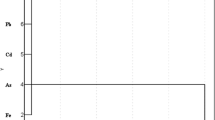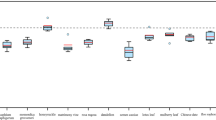Abstract
The development of the medicinal tea (MT) system has promoted the health awareness in the whole world, and the nutritional elements are also an important resource of health care delivery except for the medicinal components. Among various medicinal teas, Astragalus membranaceus (AM), Zingiberaceae rhizome (ZR), and Lonicera japonica (LJ) were the most popular ingredients in China. However, except for the nutrition value, MT was inevitably contaminated with heavy metals due to the special planting environment and processing system. This study was aimed to investigate the distribution characteristics of nutrition elements and combined health risk of heavy metals in MT sample, referring to the maximum residue limit (MRL), estimated daily intake (EDI), total target hazard quotients (TTHQs), and lifetime cancer risk (LCR). Furthermore, the bioaccessibility of gastrointestinal phase and bioavailability of human colon adeno carcinoma cell line were selected for elaborating the exact damage degree to human digestive system. The results showed that, the nutritional elements of Na, Se, K, Ca, and Mn were very rich in MT, but a total of 50% of MT were contaminated by Cr, Hg, and Cd in raw material. Although the cumulative lifetime cancer risk can be accepted under the bioaccessibility (26.62–99.27%), the heavy metals of Cr, As, Hg, and Fe in AM and LJ posed a slight threaten of non-carcinogenic risk to consumers. This study will give an exactly assessment of multiple elements in digestive system, thus further to predict the potential health risk under the consumption of MT products.






Similar content being viewed by others
References
Andrade AM, Galazzi RM, Miró M, Arruda MAZ (2020) In vitro bioaccessibility of metals from tape tea – a low-cost emerging drug. J Trace Elem Med 62:126613. https://doi.org/10.1016/j.jtemb.2020.126613
Bai X, Chai Y, Shi W, Li Y, Zhang T, Liu P (2020) Lonicera japonica polysaccharides attenuate ovalbumin-induced allergic rhinitis by regulation of Th17 cells in BALB/c mice. J Funct Foods 65:103758. https://doi.org/10.1016/j.jff.2019.103758
Clemens S (2019) Metal ligands in micronutrient acquisition and homeostasis. Plant Cell Environt 42(10):2902–2912. https://doi.org/10.1111/pce.13627
Dang Z, Li Q, Sun S, Wang Y, Lin R, Zhang Y, Dai J, Zheng N (2019) The medicinal plant pair Bupleurum chinense-Scutellaria baicalensis – metabolomics and metallomics analysis in a model for alcoholic liver injury. Front Pharmacol 10:254. https://doi.org/10.3389/fphar.2019.00254
Finley JW (2003) Reduction of cancer risk by consumption of selenium-enriched plants: enrichment of broccoli with selenium increases the anticarcinogenic properties of broccoli. J Med Food 6:19–26. https://doi.org/10.1089/109662003765184714
Foroughi A, Pournaghi P, Najafi F, Zangeneh A, Zangeneh MM, Moradi R (2017) Medicinal plants: antibacterial effects and chemical composition of essential oil of Foeniculum vulgare. Int J Current Pharm Rev and Res 8(1):13–17. https://doi.org/10.25258/ijcprr.v8i01.9082
Fu Z, Xi S (2020) The effects of heavy metals on human metabolism. Toxicol Mech Methods 30:167–176. https://doi.org/10.1080/15376516.2019.1701594
Gu YG, Ning JJ, Ke CL, Huang HH (2018) Bioaccessibility and human health implications of heavy metals in different trophic level marine organisms: a case study of the South China Sea. Ecotoxico Environ Saf 163:551–557. https://doi.org/10.1016/j.ecoenv.2018.07.114
Guo D, Murdoch CE, Liu T, Qu J, Jiao S, Wang Y, Wang W, Chen X (2018) Therapeutic angiogenesis of Chinese herbal medicines in ischemic heart disease. A review. Front Pharmacol 26:428. https://doi.org/10.3389/fphar.2018.00428
Hejna M, Gottardo D, Baldi A, Dell’Orto V, Cheli F, Zaninelli M, Rossi L (2018) Review: Nutritional ecology of heavy metals. Animal 12:2156–2170. https://doi.org/10.1017/s175173111700355x
ISO 18864, International Standard Traditional Chinese Medicine-Determination of heavy metals in herbal medicines used in Traditional. (2015)
Jain RB (2019) Co-exposures to toxic metals cadmium, lead, and mercury and their impact on unhealthy kidney function. Environ Sci Pollut Rese Int 26:30112–301188. https://doi.org/10.1007/s11356-019-06182-y
Kalantari K, Moniri M, BoroumandMoghaddam A, Abdul Rahim R, Bin Ariff A, Izadiyan Z, Mohamad R (2017) A review of the biomedical applications of zerumbone and the techniques for its extraction from ginger rhizomes. Molecules 22:1645. https://doi.org/10.3390/molecules22101645
Keshavarzi B, Hassanaghaei M, Moore F, RastegariMehr M, Soltanian S, Lahijanzadeh AR, Sorooshian A (2018) Heavy metal contamination and health risk assessment in three commercial fish species in the Persian Gulf. Mar Pollut Bull 129:245–252. https://doi.org/10.1016/j.marpolbul.2018.02.032
Kolon M, Kopeć M, Wojtuń B, Samecka-Cymerman A, Mróz L, Wąsowicz P, Rajsz A, Kempers, Alexander J (2020) Sanionia uncinata, Racomitrium lanuginosum and Salix herbacea as ecological indicators of metals in Iceland. Ecoll Indic 112:106058. https://doi.org/10.1016/j.ecolind.2019.106058
Kong DD, Li XY, Yao JJ, He YL, Luo JY, Yang MH (2020) Health risk assessment and bioaccessibility of toxic elements in edible and medicinal plants under different consumption methods. Microchem J 159:105577. https://doi.org/10.1016/j.microc.2020.105577
Laokor N, Juntachai W (2021) Exploring the antifungal activity and mechanism of action of Zingiberaceae rhizome extracts against Malassezia furfur. J Ethnopharmacol 279:114354. https://doi.org/10.1016/j.jep.2021.114354
Li L, Zheng S, Brinckmann JA, Fu J, Zeng R, Huang L, Chen S (2017) Chemical and genetic diversity of Astragalus mongholicus grown in different eco-climatic regions. PLoS One 12:e0184791. https://doi.org/10.1371/journal.pone.0184791
Liu J, Zhao Y, Zhang Y, Yao X, Hang R (2021) Exosomes derived from macrophages upon Zn ion stimulation promote osteoblast and endothelial cell functions. J Materi Chem B 9:3800–3807. https://doi.org/10.1039/d1tb00112d
Liu P, Xiao W, Wang K, Yang Z, Wang L (2021) Bioaccessibility of Cd and its correlation with divalent mineral nutrients in locally grown rice from two provinces in China. Biol Trace Elem Res 200:1408–1417. https://doi.org/10.1007/s12011-021-02706-1
Liu XH, Ji J, Zhou XC (2015) Study on the correlation between the effect of enriching the blood in tradition Chinese medicine and iron content. Guangdong Trace Elements Science 10:283–298. https://doi.org/10.14257/ijmue.2015.10.3.26
Meerpoel C, Vidal A, Andjelkovic M, de Boevre M, Tangni EK, Huybrechts B, Devreese M, Croubels S, de Saeger S (2021) Dietary exposure assessment and risk characterization of citrinin and ochratoxin A in Belgium. Food ChemToxicol 147:111914. https://doi.org/10.1016/j.fct.2020.111914
Mojadadi A, Au A, Salah W, Witting P, Ahmad G (2021) Role for selenium in metabolic homeostasis and human reproduction. Nutrients 13:3256. https://doi.org/10.3390/nu13093256
Ollson CA, Koch I, Smith P, Knopper LD, Hough C, Reimer KJ (2009) Addressing arsenic bioaccessibility in ecological risk assessment: a novel approach to avoid overestimating risk. Environ Toxicol Chem 28:668–675. https://doi.org/10.1897/08-204.1
Ozyigit II, Yalcin B, Turan S, Saracoglu IA, Karadeniz S, Yalcin IE, Demir G (2018) Investigation of heavy metal level and mineral nutrient status in widely used medicinal plants’ leaves in Turkey: insights into health implications. Biol Trace Elem Res 182:387–406. https://doi.org/10.1007/s12011-017-1070-7
Park J, Jeong D, Song M, Kim B (2021) Recent advances in anti-metastatic approaches of herbal medicines in 5 major cancers: from traditional medicine to modern drug discovery. Antioxidants 10:527. https://doi.org/10.3390/antiox10040527
Parrino V, Costa G, Giannetto A, de Marco G, Cammilleri G, Acar Ü, Piccione G, Fazio F (2021) Trace elements (Al, Cd, Cr, Cu, Fe, Mn, Ni, Pb and Zn) in Mytilus galloprovincialis and Tapes decussatus from Faro and Ganzirri Lakes (Sicily, Italy): flow cytometry applied for hemocytes analysis. J Trace Elem Med Biolo 68:126870. https://doi.org/10.1016/j.jtemb.2021.126870
Pharmacopoeia Committee of People’s Republic China (2020) Pharmacopoeia of People’s Republic China. Chemical Industry Publishers, Beijing, China
Pilon-Smits EA, Quinn CF, Tapken W, Malagoli M, Schiavon M (2009) Physiological functions of beneficial elements. Curr Opin Plant Biol 12:267–274. https://doi.org/10.1016/j.pbi.2009.04.009
Raab A, Stiboller M, Gajdosechova Z, Nelson J, Feldmann J (2016) Element content and daily intake from dietary supplements (nutraceuticals) based on algae, garlic, yeast fish and krill oils—should consumers be worried? J Food Compos Anal 53:49–60. https://doi.org/10.1016/j.jfca.2016.09.008
Roselli C, Desideri D, Meli MA, Fagiolino I, Feduzi L (2016) Essential and toxic elements in meat of wild birds. J Toxicol Environ Health A 79:1008–1014. https://doi.org/10.1080/15287394.2016.1216490
Salehi B, Carneiro JNP, Rocha JE, Coutinho HDM, Morais Braga MFB, Sadaka C (2021) Astragalus species: insights on its chemical composition toward pharmacological applications. Phytother Res 35:6974. https://doi.org/10.1002/ptr.6974
Sawut R, Kasim N, Maihemuti B, Hu L, Abliz A, Abdujappar A, Kurban M (2018) Pollution characteristics and health risk assessment of heavy metals in the vegetable bases of northwest China. Sci Total Environ 642:864–878. https://doi.org/10.1016/j.scitotenv.2018.06.034
Sheik A, Kim K, Varaprasad GL, Lee H, Kim S, Kim E, Shin J-Y, Oh SY, Huh YS (2021) The anti-cancerous activity of adaptogenic herb Astragalus membranaceus. Phytomedicine 91:153698. https://doi.org/10.1016/j.phymed.2021.153698
Shi YH, Xiao JJ, Feng RP, Liu YY, Liao M, Wu XW, Hua RM, Cao HQ (2017) In-vitro bioaccessibility of five pyrethroids after human ingestion and the corresponding gastrointestinal digestion parameters: a contribution for human exposure assessments. Chemosphere 182:517–524. https://doi.org/10.1016/j.chemosphere.2017.05.081
Srivastava D, Tiwari M, Dutta P, Singh P, Chawda K, Kumari M, Chakrabarty D (2021) Chromium stress in plants: toxicity, tolerance and phytoremediation. Sustainability 13:4629. https://doi.org/10.3390/su13094629
Tokalıoğlu Ş, Clough R, Foulkes M, Worsfold P (2020) Stability of arsenic species during bioaccessibility assessment using the in vitro UBM and HPLC-ICP-MS detection. Biol Trace Elem Res 198:332–338. https://doi.org/10.1007/s12011-020-02066-2
Tu C, Wei J, Guan F, Liu Y, Sun Y, Luo Y (2020) Biochar and bacteria inoculated biochar enhanced Cd and Cu immobilization and enzymatic activity in a polluted soil. Environ Inte 137:105576. https://doi.org/10.1016/j.envint.2020.105576
Wachirawongsakorn P (2016) Health risk assessment via consumption of Pb and Cd contaminated vegetables collected from fresh markets in the lower north of Thailand. Hum Ecol Risk Assess An Int J 22:611–622. https://doi.org/10.1080/10807039.2015.1095631
Weber AM, Baxter BA, McClung A, Lamb MM, Ryan EP (2021) Arsenic speciation in rice bran: agronomic practices, postharvest fermentation, and human health risk assessment across the lifespan. Environ Pollut 290:117962. https://doi.org/10.1016/j.envpol.2021.117962
Wragg J, Cave M, Basta N, Brandon E, Casteel S, Denys S, Gron C, Oomen A, Reimer K, Tack K, van de Wiele T (2011) An inter-laboratory trial of the unified BARGE bioaccessibility method for arsenic, cadmium and lead in soil. Sci Total Environ 409:4016–4030. https://doi.org/10.1016/j.scitotenv.2011.05.019
Xu FF, Song J, Li YQ, Lai YF, Lin J, Pan JL, Chi HQ, Wang Y, Li ZY, Zhang GQ, Cai ZF, Liang XX, Ma AD, Tan CT, Wu WL, Yang XF (2021) Bioaccessibility and bioavailability adjusted dietary exposure of cadmium for local residents from a high-level environmental cadmium region. J Hazard Mater 420:126550. https://doi.org/10.1016/j.jhazmat.2021.126550
Zehra S, Tabassum S, Arjmand F (2021) Biochemical pathways of copper complexes: progress over the past 5 years. Drug Discov Today 26:1086–1096. https://doi.org/10.1016/j.drudis.2021.01.015
Zhou X, He G, Ma J, Tang M, Tian G, Gong X, Zhang H, Kui L (2020) Protective effect of a novel polysaccharide from Lonicera japonica on cardiomyocytes of mice injured by hydrogen peroxide. BioMed Res Int 5279193. https://doi.org/10.1155/2020/5279193
Zhu X, Li MY, Chen XQ, Wang JY, Li LZ, Tu C, Luo YM, Li HB, Ma LQ (2019) As, Cd, and Pb relative bioavailability in contaminated soils: coupling mouse bioassay with UBM assay. Environ Int 130:104875. https://doi.org/10.1016/j.envint.2019.05.069
Zidan AS, Spinks CB, Habib MJ, Khan MA (2013) Formulation and transport properties of tenofovir loaded liposomes through Caco-2 cell model. J Liposome Res 23:318–326. https://doi.org/10.3109/08982104.2013.810645
Zimmermannova O, Felcmanova K, Sacka L, Colinet A-S, Morsomme P, Sychrova H (2021) K+-specific importers Trk1 and Trk2 play different roles in Ca2+ homeostasis and signalling in Saccharomyces cerevisiae cells. FEMS Yeast Res 21:foab015. https://doi.org/10.1093/femsyr/foab015
Zulkafflee NS, Redzuan NAM, Selamat J, Ismail MR, Praveena SM, Razis AFA (2020) Evaluation of heavy metal contamination in paddy plants at the Northern Region of Malaysia using ICPMS and ITS RISK ASSESSMENT. Plants (Basel) 10:3. https://doi.org/10.3390/plants10010003
Funding
This work was supported by the National Natural Science Foundation of China (81903797) and the CAMS Innovation Fund for Medical Science (CIFMS) (No. 2021–1-I2M-031, 2021-I2M-1–071).
Author information
Authors and Affiliations
Contributions
Dandan Kong and Meihua Yang: funding acquisition, conceptualization, methodology, data curation, and paper writing; Ming Sui, Haonan Ruan, Xinqi Sun, Wei Gu, and Mengyue Guo: investigation, methodology, and paper writing; Shumin Ding: funding acquisition, project administration, resources, and supervision.
Corresponding authors
Ethics declarations
Competing Interest
The authors declare no competing interests.
Additional information
Publisher’s Note
Springer Nature remains neutral with regard to jurisdictional claims in published maps and institutional affiliations.
Supplementary Information
Below is the link to the electronic supplementary material.
Rights and permissions
About this article
Cite this article
Sui, M., Kong, D., Ruan, H. et al. Distribution Characteristics of Nutritional Elements and Combined Health Risk of Heavy Metals in Medicinal Tea from Genuine Producing Area of China. Biol Trace Elem Res 201, 984–994 (2023). https://doi.org/10.1007/s12011-022-03173-y
Received:
Accepted:
Published:
Issue Date:
DOI: https://doi.org/10.1007/s12011-022-03173-y




